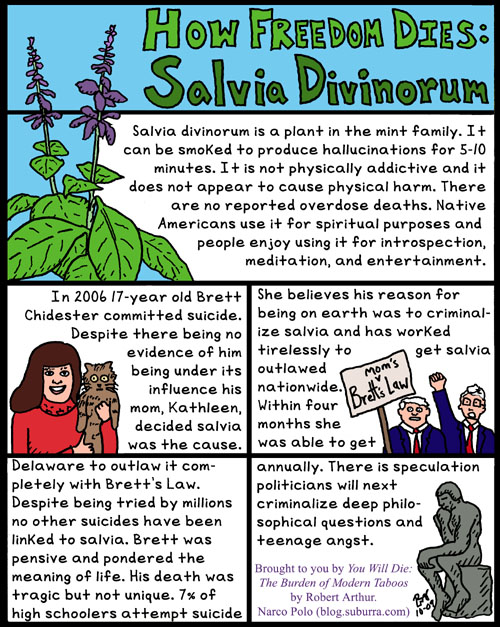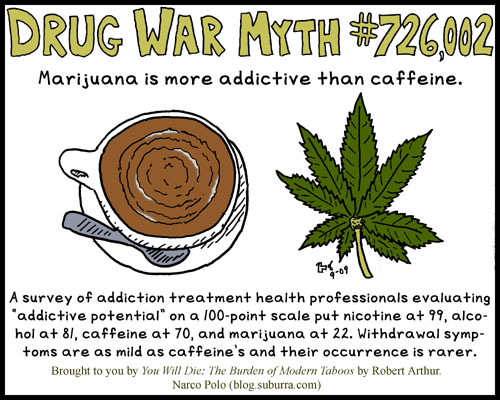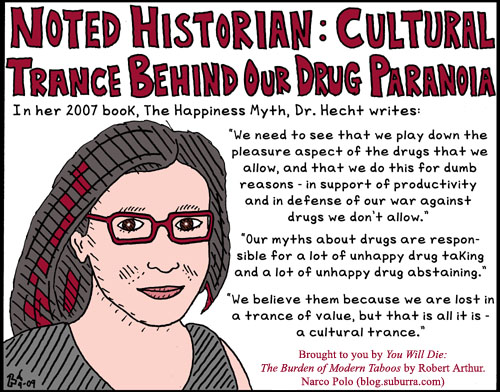Posted: October 6th, 2009 | Filed under: drugs, hallucinogens, media bias, Salvia divinorum | 21 Comments »

The above story of Salvia divinorum demonstrates how anecdotal evidence is bizarrely abused to create and foster the war on drugs. In modern America’s narcophobic climate one death out of millions of users can cause all adult users to be deemed criminals worthy of prosecution and incarceration.
Salvia is a particularly astonishing case because the “salvia death” of Brett Chidester that is paraded by the media and politicians is on such shaky ground:
1. His family admits he had some depression issues. His cousin, Danielle Chidester, wrote in a March 30, 2006 blog comment:
While it is true that he used to not be as happy as he was before he died, he completely changed his life around. He told me how he was so glad that he was finally happy. (swanksalot)
2. There is no evidence he was on salvia when he died. (DuLac) Because of the incapacitating effects of salvia it is unlikely he would have had the ability to take the actions he did. (He set up a tent in a garage and lit a grill inside of it to asphyxiate himself.)
3. The written passages which several media outlets, e.g. USA Today, have called a suicide note were not a suicide note at all. They are snippets from material written well before his death and read like this one:
Salvia allows us to give up our senses and wander in the interdimensional time and space. Also, and this is probably hard for most to accept, our existence in general is pointless. We earthly humans are nothing. (Doward)
4. The death certificate which the media refers to as listing salvia as a contributory cause of death initially did not mention salvia at all. It was three months after his death (and a day after the passage of Delaware’s “Brett’s Law”) that a Delaware medical examiner revised the death certificate. She refused to comment on the change. (Chalmers, 5/6/06) For more on the drug politics behind autopsies go to this post.
5. In an interview shortly after Brett’s death Kathleen admitted the basis of her salvia indictment was merely a “gut feeling.”
We just won’t have any answers, and we have to learn to accept that. But my gut feeling is it was the salvia. It’s the only thing that can explain it. (Chalmers, 2/26/06)
Due to Kathleen Chidester’s efforts, in places like Florida people like her son can now face up to five years in prison for possession of Salvia divinorum.
Oddly enough, despite believing Brett was put on earth to have salvia criminalized (Chidester), Kathleen doubts Brett would approve, “I don’t think Brett would want to be known for a law like that, but I think of it as an honor.” (Chalmers, 3/23/06)
Sidebar: Ingesting high amounts of caffeine, e.g. No-Doz, can lead to hallucinations and even death.
Rays of Sanity: California and Maine only criminalized salvia for minors.
Asinine Sensationalistic Headlines:
“Deadly Dangers of a Street Legal High” – Todd Quinones, CBS 3 Philadelphia, 30 Nov. 2006.
“New Legal Herb May Do More Damage Than LSD” – Devine, Josh, ABC12 (WJRT, MI) 19 Feb. 2007. (The only damage LSD has been found to cause is precipitating mental illness in those already predisposed to mental illness.)
“Salvia: Legal but Lethal” – Anderson Cooper, CNN, 13 Apr. 2006.
Quotes of Note:
If you’re that retarded to go ahead and try to defend the drug then you deserve whatever the hell happens to you. (swanksalot)
Danielle Chidester in one of her many comments on a blog entry written by a “dumbass” (her word) questioning salvia’s link to Brett’s death.
Three days after he died, some friend of his named Mike shared “fond memories” of Brett on MySpace; mentioning how Brett stole alcohol from his job on a regular basis. He also talked about Brett driving drunk and puking out of the window after they had gotten hammered on Absinthe. (swanksalot)
AssaultedReason responding to Danielle and comparing/contrasting alcohol/salvia treatment in his own comment. (This MySpace page is apparently no longer available.)
Links of Note:
Kathleen Chidester’s blog, “Brett Chidester – Stolen Angel.”
Kathleen Chidester interviewed on ABC’s Nightline.
Legal Status of Salvia by Country and State on Wikipedia.
Sources:
1. Mike Chalmers, “Legal High New Worry for Parents,” News Journal (DE), 26 Feb. 2006. LINK
2. Mike Chalmers, “Proposal Would Outlaw Hallucinogenic Salvia,” News Journal (DE), 23 Mar. 2006. LINK
3. Mike Chalmers, “Salvia’s Banned, But Now the Tough Part,” News Journal (DE), 6 Mar. 2006. LINK
4. Kathleen Chidester, “Brett’s Mom Forever,” Brett Chidester – Stolen Angel (blog), ret. 5 Oct. 2009. LINK
5. Jamie Doward & Oliver Shah, “Legal Highs,” Guardian, 26 Apr. 2009. LINK
6. J. Freedom DuLac, “Hallucinogenic Herb Under Legislative Eye,” Washington Post, 30 Sep. 2009. LINK
7. “Suicide: Facts at a Glance,” CDC, Summer 2009. LINK
8. swanksalot, “Mindless Drug Propaganda,” B12 Solipsism (blog), 26 Feb 2006. LINK
Posted: September 21st, 2009 | Filed under: drugs, marijuana, media bias | 6 Comments »

In covering the marijuana legalization debate the mainstream media is prone to comparing marijuana addictiveness to alcohol, cocaine, and heroin. A much more appropriate comparison would be to caffeine. This would provide a better perspective to the media’s dramatic portrayals of marijuana “addicts.” (See New York Times portrayal of “Joyce” here.)
The health professional survey mentioned above that ranked the inherent addictive potential of numerous drugs on a 100-point scale (nicotine 99, alcohol 81, caffeine 70, and marijuana 22) was taken from Perrine. (p. 7)
The statement that marijuana withdrawal symptoms are as mild as caffeine’s and their occurrence is rarer is taken from Gahlinger. (pp. 180, 333)
Most marijuana users – even those with long-term, heavy use – experience no withdrawal when they stop. Some people have reported generally mild symptoms …. (Gahlinger, p. 333)
Thanks to Pete Guither at Drug WarRant for the following posts which alerted me to this issue: “Times Article Buys into Marijuana Addiction Based on Anecdotal Evidence from Idiots” and “ABC News Goes Reefer Madness.”
Sources:
1. Paul Gahlinger, Illegal Drugs (2001).
2. Daniel Perrine, Chemistry of Mind-Altering Drugs (1996).
Posted: September 16th, 2009 | Filed under: cocaine, drugs, history, marijuana, opiates | 2 Comments »

In her popular 2007 book, The Happiness Myth: Why What We Think Is Wrong, historian Jennifer Michael Hecht calls our current demonization of drugs a “cultural trance.” (p. 71) Just like past irrational attitudes the modern view of drugs may eventually reveal itself as, “bossy, shaming, controlling nonsense.” (p. 2)
People follow the conventional wisdom of their era in pursuing happiness. Hecht points out that experts have been proven wrong throughout history and that there is no reason to believe the current batch will fare any better. She reveals numerous “nonsensical cultural assumptions” about drugs, the primary one being that drug induced happiness is inferior to sober happiness. (p. 7)
It wasn’t until the early 20th century that pleasure via drugs was characterized as “naughty.” All cultures have had favorite chemicals to feel better. (The Bible repeatedly advocates using alcohol for joy.) This history has been whitewashed in America. For example, few know that marijuana has been smoked from braziers in Europe since the onset of agriculture roughly 5,000 years ago or that the French Renaissance literary character, the giant Pantagruel, was named after marijuana and smoked it constantly.
Hecht dares to point out that even addiction can be pleasurable. Much of America is addicted to caffeine and looks forward to their “boosts.” They do not suffer because caffeine is freely available. In other cultures and times opiates and cocaine were used in a similarly benign fashion, i.e. laudanum in the West and coca chewing in South America.
Hecht explains how easily our drug attitudes could have been formed differently and how arbitrary our drug categories are. If coca leaves transported easier, chewing may have caught on in Europe and there may have been more resistance to the cocaine prohibitionists. Likewise if caffeine is “chemically goosed” to provide an intense high, caffeine might become a target of the drug war. (p. 92)
In Native American culture there were periodic festivals involving dancing and the closely supervised administration of drugs which brought about spiritual revelation and euphoria. Teenagers participated. A longing for these experiences still exists as, “many people, especially young people, say they are never happier than when they are a little high and listening to live music, or dancing.” (p. 118) However, in current American culture this behavior has been criminalized due to our “pharmacological Calvinism” so young adults who persist must get their substances from the black market and consume them without supervision. (p. 119)
Hecht lists circumstances in which she suggests one consider using drugs. Some of them are:
1. If you long for a break from your “symptoms” or merely from your personality.
2. If you want to know more about the nature of reality and how the mind creates it.
3. If you want to have an intense communing experience with someone.
4. If you want to have a good time on a given evening.
5. If you want to dance and be social, but you are too inhibited.
Hecht cautions people against using illegal drugs in the current environment and recognizes their dangers. However, she writes that life is full of risky behaviors, e.g. driving cars, mountain climbing, living a sedentary life. The risks and benefits are balanced when deciding whether to regulate or criminalize these activities, but with drugs modern policy makers completely discount the happiness that drugs bring.
Modern pundits who claim we are dosing ourselves too freely are not speaking with historical knowledge or philosophical sense. Keeping your mind in only one place is not a very assertive way to relate to life, to search it for happiness, or for truth. (p. 127)
The Happiness Myth: Why What We Think Is Wrong also covers false cultural assumptions in the areas of wisdom, money, bodies, and celebration.





